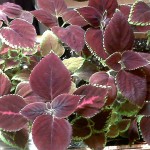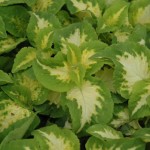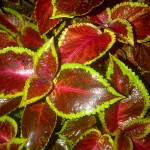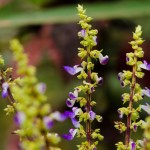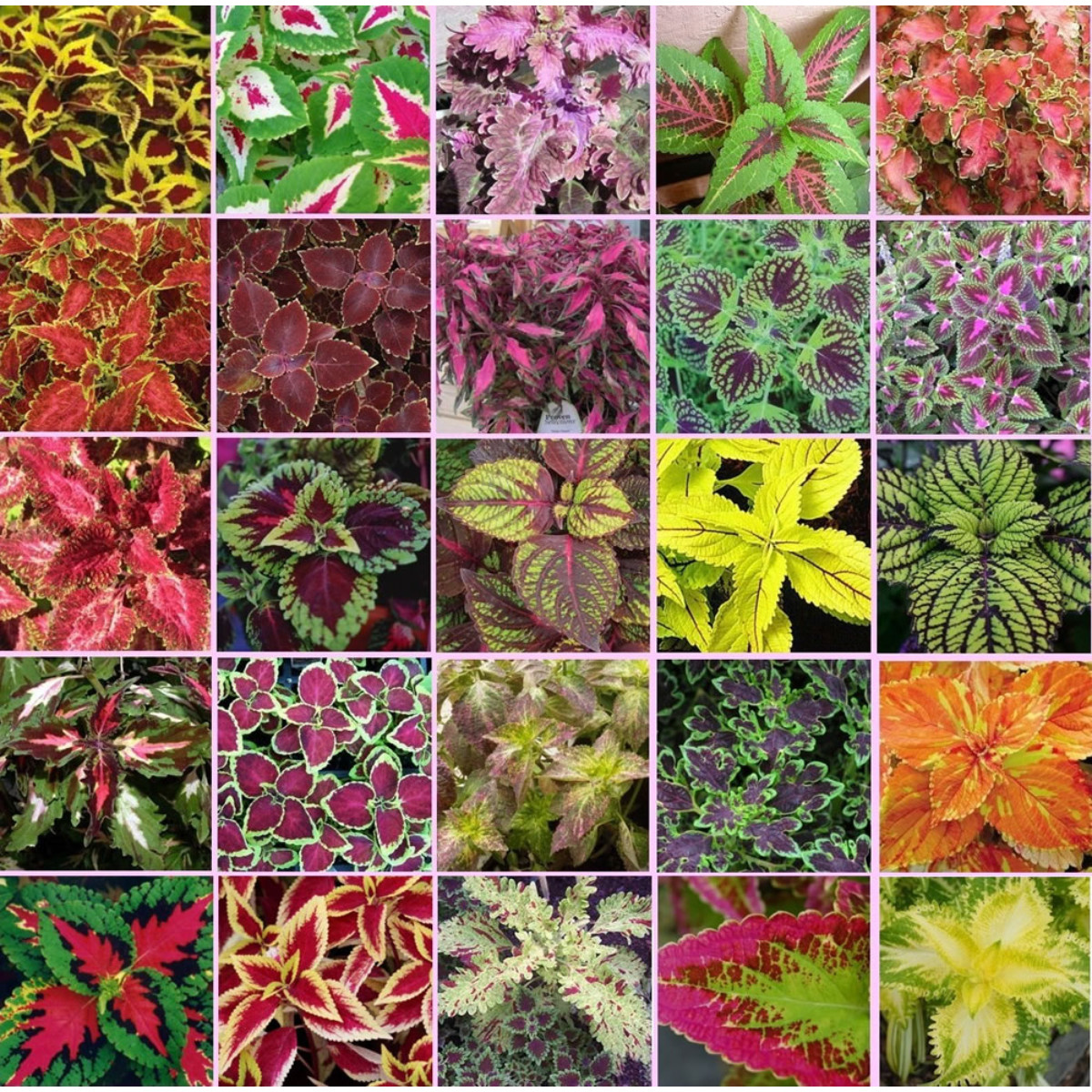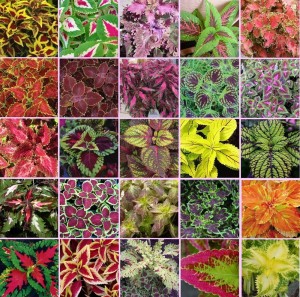Family: Lamiaceae
Synonymous: Coleus blumei
Coleus blumei var. verschaffeltii
Coleus hybridus
Coleus pumilus
Coleus scutellarioides
Coleus verschaffeltii
Ocimum scutellarioides
Plectranthus scutellarioides
Distribution and habitat: Solenostemon scutellarioides is native to south east Asia and Malaysia. Growing to 6075cm (2430 inch) tall and wide, it is a bushy, woody-based evergreen perennial, widely grown for its highly decorative variegated leaves. It has been assiduously hybridized over the years into a very large number of vegetative propagated and seed propagated strains with an almost infinite number of leaf color combinations including most colors of the spectrum except true blue.
Description: Although Solenostemon scutellarioides plants are perennials, many growers treat them as temporary foliage plants, to be enjoyed and then discarded when past their best. This is because they are sometimes difficult to overwinter and also because they are easy to grow from cuttings. Their soft, rather thin leaves very considerably in shape, size and colour (which can be almost any shape of yellow, red, orange, green or brown or a mixture of three or more of these). Solenostemon scutellarioides plants have opposite leaves and blue to lilac colored flower spikes. Such flowers as they produce have little decorative value and are best nipped out when they are still developing; this procedure will help to keep the plants bushy.
Solenostemon scutellarioides is the only species ofSolenostemon commonly grown as indoor plant. Some of its forms have hart-shaped leaves and others have slender, sometimes contorted pendulous leaves. Young seedlings only 2-5cm (0.8-2 inch) high, but already showing their true colour, can be bought in spring and these may grow into 60cm (24 inch) tall plants in one season. Named hybrids of this species are also frequently available.
Houseplant care: All Solenostemon scutellarioides should have their growing tips nipped out regularly to help them remain bushy. The flowers are best pinched out before they form to keep the plant in good shape.
If the plant is kept for a second season, prune it back to about one third of its original size in late winter or very beginning of spring.
Light: Provide bright light at all times - including several hours a day of direct sunlight, if possible. Insufficient light will result in spindly growth.
Temperatures: Solenostemon scutellarioides do well in warm rooms. In temperatures above 18C (64F), though, the air should be humidified by standing plants on trays of damp pebbles or moist peat moss. If the temperature is allowed to fall much bellow 13C (55F) leaves are in danger of wilting and dropping down.
Watering: These plants should be watered plentifully as often as necessary to keep the potting mixture thoroughly moist. If the mixture is permitted to dry out even for a short period, the leaves of Solenostemon scutellarioides will collapse; and although plants may appear to recover fully when they are watered once more the lower leaves will probably still drop off.
If the plant is being kept over winter then reduce watering and keep this plant on the dry side.
Avoid getting the velvety leaves wet. Hard water will cause white spots which cannot be washed off. Always use room-temperature water when watering these houseplants.
Feeding: Apply a liquid fertiliser about every two weeks throughout the active growth period.
Potting and repotting: Use a soil based potting mixture. Young plants should be moved every two months into pots two size larger. Solenostemon scutellarioides should not be underpotted; they need room for their active roots to develop freely.
Gardening: Solenostemon scutellarioides plants are frost tender, so in most climates, they are grown as annuals. They are heat-tolerant, but they do less well in full sun in subtropical areas than in the shade. In mild areas (no snow in winter), plants can usually be kept as perennials if well managed. In colder areas, they are often grown as annuals, since the plants are not hardy and become leggy with age.
To keep the foliage lush, pinch out flower spikes as they develop. Pinch plant stem tips to keep plants compact and to promote bushiness.
Harden the seedlings off before planting them outdoors. Solenostemon scutellarioides plants should not be set into the landscape until the minimum outdoor temperature is 10C (50F).
Location: Plant Solenostemon scutellarioides plants in partial shade setting. In hot areas, the colors of the plant are likely to be more intense when it is planted in shaded areas rather than in full sun. Also, the plants will require less water in shaded than in full sun position.
Soil: Solenostemon scutellarioides prefers fertile, evenly moist, well-draining soil. It is adapted to chalk, clay, clay loam, loam, loamy sand, peat, sandy clay, sandy clay loam and sandy loam soils.
Plant them 30cm (12 inch) apart in rich, moist, well-drained soil preferable with a neutral or slightly alkaline pH.
Irrigation: It requires an evenly moist well-drained soil for optimal growth, but will die in standing water. If the soil is allowed to dry out, the foliage will wilt, but normally will recover quickly when water is provided. Water your plants thoroughly at planting time.
Consider applying a thick mulch around the root zone over the growing season to conserve soil moisture. The mulch will also help to heat up and retain the heat in the soil, thereby helping the new plants to get quickly established.
Fertilise: Feed these plants with a liquid fertiliser once a month.
Propagation: Young, freshly rooted plants overwinter much better than older plants. Tip cuttings about 5-8cm (2-3 inch) long taken in early autumn will root easily either in the standard potting mixture or water.
If started in water, they should be moved into the potting mixture when roots are 5-8cm (2-3 inch) long. Cuttings started in potting mixture will normally root in about two weeks if they are kept in a warm, brightly lit position, without direct sunlight. Water the cuttings enough to make the potting mixture moist, but allow the top centimetre (0.4 inch) or so of the potting mixture to dry out completely between waterings.
Seed propagation is also possible, but they will not come true from seeds.
Problems: Usually problems appear as the result of incorrect treatment of the plant.
In hot, dry rooms red spider mites can cause discolouration and leaf withering.
Treatment: Wash off any heavy infestation of red spider mites under the tap. To prevent an infestation of these pests it is important to provide a humid atmosphere around the plants and to spray the plants with water occasionally.
Leaf fall indicates that the plant is in a poor light position.
Straggly growth may also be sue to poor light or it may occur as a consequence of failure to pinch out the growing tips.
Recommended varieties:
Solenostemon X 'Brilliancy' which has crimson-red leaves that are market with golden yellow at the edges.
Solenostemon X 'Candidus' which has a white patch in the centre of the undulate, pale green leaves.
Solenostemon X 'Golden Bedder' which has lemon yellow leaves deepening to gold in bright light.
Solenostemon X 'Pink Rainbow' which has undulate, coppery red leaves marked with green bands and carmine-red veining.
Solenostemon X 'Sunset' which has a pink patch in the centre of its leaves.
Note: As members of the Mint family of plants (Lamiaceae), Solenostemon species are close relatives of Mentha arvensis (peppermint), Mentha viridis (spearmint), Salvia officinalis (sage), Ocimum basilicum (basil), Thymus vulgaris (thyme), Origanum vulgare (oregano) and Plectranthus verticillatus (Swedish ivy).
Solenostemon scutellarioides may became invasive in warm climates.
Uses and display: Solenostemon scutellarioides has the most incredible foliage with colors and color combinations that no other plant species can offer. The leaves are gorgeous with their frilly edges and unique color patterns. These plants are easy-care, versatile and their foliage colour, again, can only be described as spectacular! They combine well with flowering annuals to create more texture and interest or it is a great stand-alone in a container or bed. These plants can be used for group or mass as garden annuals in beds and borders; pots, containers, window boxes, hanging baskets; houseplants.
SUMMARY:
CHARACTERISTICS:
Foliage coloured
Shape bushy
Height: 45-60cm (18-24 inch)
PROPER CARE:
Watering in active growth period plentifully
Light direct
Temperature in active growth period min 16C max 24C (61-75F)
Humidity high
Hardiness zone: 10a-11
